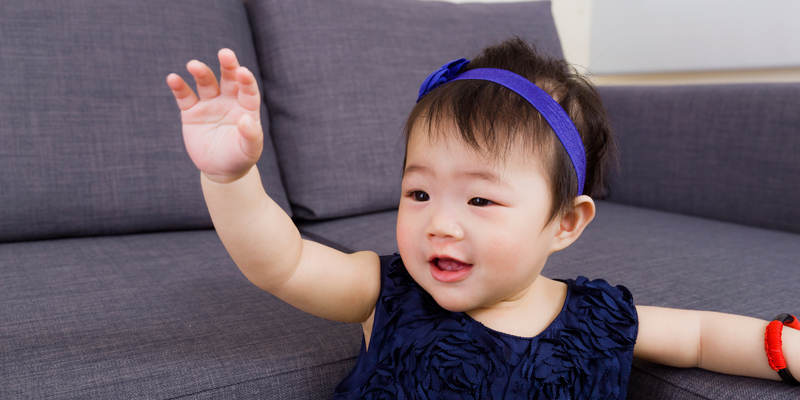
The Many Uses of Gesture Language
Does your baby nod her head yes? Does she clap her hands when excited, or wave bye-bye? Gestures are important to her, since at this age she’s aware that there’s a big world of people communicating with one another, and she most likely wants to take part in all the action. However, because her Expressive Language skills — that is, her speaking abilities — are still immature, she will often use her Gesture Language skills along with babbling to get her point across.1,2 You will notice her using simple gestures, such as shaking her head to say “no” or waving “bye-bye” when someone is leaving the room. She may make grabbing motions toward objects she wants, hold up her arms asking to be picked up, or use a combination of pointing and vocalizing to let you know what she wants. She may also more actively copy your motions in familiar songs and finger plays, like “Peek-a-Boo” and “Itsy Bitsy Spider.”
Help your baby build her supply of gestures by teaching her simple sign language. While baby sign language has been around for quite a while and has been used by many parents and their infants, there has been some debate concerning its use. Some people worry that teaching sign language, or even a foreign language, may delay the verbal Expressive Language skills of a child’s native language.3 In fact, studies looking at the use of sign language by infants have shown overwhelmingly positive results.1,4 By teaching your baby simple gestures for common words, you will help her communicate better, cut down on frustration (yours and hers!), and develop self-confidence.
(SPECIAL OFFER: Sign up for Playful Bee’s Bee Well developmental learning program to give your baby the best start in life. The first 10,000 children enroll for FREE! Sign up today.)
Play Tips:
Do you want to know how you can support your baby’s development of these Gesture Language skills at this age? It’s easy! Read on for some simple tips to incorporate into your daily play time together.
- Introduce simple sign language and gestures for common words. While your baby will be too young to learn complicated signs, she’s capable of many simple ones. Focus on everyday words such as “hungry,” “diaper,” “nap,” “milk” and “more.” Learning useful gestures will help her let you know her needs and reduce frustration and tears.
- Use hand gestures and facial expressions when you speak. By using gestures together with words on a regular basis, you can help boost your baby’s language skills. For instance, the next time you have to leave her with the babysitter, give an enthusiastic wave as you say “good-bye.”
- Sing finger play songs together. Songs that use body movement or hand motions are often a favorite for many young children. Not only does it add interest to the song, but the motions help your baby develop hand-eye coordination and fine motor skills. Consider such classics as “The Wheels on the Bus” or “Pat-a-Cake.” At the beginning, your baby may need your help to make the gestures. Over time, she will learn to mimic the motions on her own. As she gets older, you can try some great directional songs, like “The Hokey Pokey,” to encourage language skills and following directions.
(SPECIAL OFFER: Sign up for Playful Bee’s Bee Well developmental learning program to give your baby the best start in life. The first 10,000 children enroll for FREE! Sign up today.)
Developmental Milestones:
Has your baby achieved the following Gesture Language developmental milestones yet? If yes, check off all the skill(s) she has already mastered to date using Playful Bee’s developmental milestones tracker. It’s absolutely FREE and easy to use, just click HERE!
- Uses simple gestures, like shaking head “no” or waving “bye-bye”.
- Imitates gestures using hand-eye coordination (e.g. high-five and thumbs-up).
- Mimics actions in familiar songs and finger plays (e.g. “Peek-a-Boo” and “Pat-a-Cake”).
Sources:
1Capone, Nina C. and McGregor, Karla K. (2004). Gesture Development: A Review for Clinical and Research Practices. Journal of Speech, Language, and Hearing Research, 47, 173-186.
2Capone, Nina C. (2007). Tapping Toddlers’ Evolving Semantic Representation via Gesture. Journal of Speech, Language, and Hearing Research, 50 (3), 732-745.
3Soto, Roxana A. Raising a Bilingual Child: The Top Five Myths. Baby Center. Retrieved December 13, 2013, from http://www.babycenter.com/0_raising-a-bilingual-child-the-top-five-myths_10340869.bc.
4Morgan, James (2009). Gestures “Develop Infant Speech.” BBC News. Retrieved December 16, 2013, from http://news.bbc.co.uk/2/hi/uk_news/education/7887446.stm.
Playful Bee
Latest posts by Playful Bee (see all)
- Have a Super Fortune Cookie Friday! - February 9, 2018
- All Kinds of Shapes: Your Child Is Learning Simple Shapes, and Drawing Them Too! - November 13, 2017
- Fishing for Sneakers: Create your own Hand-Eye Coordination Fun - November 11, 2017

+ There are no comments
Add yours